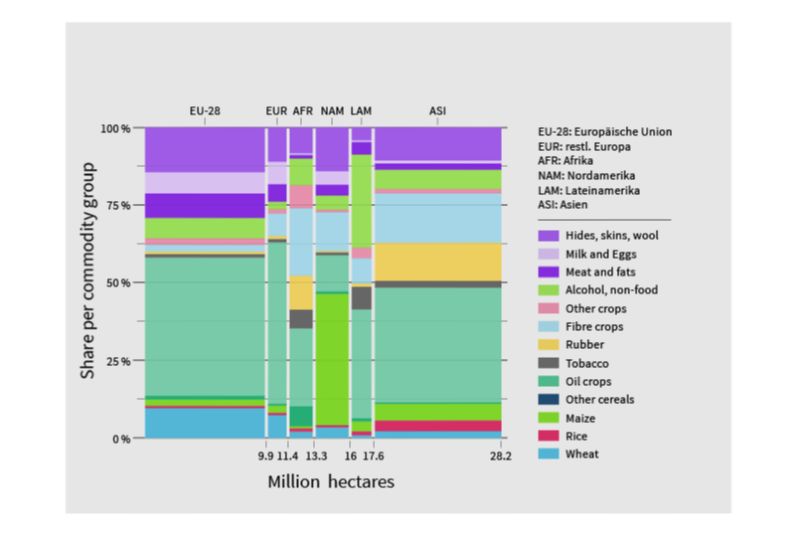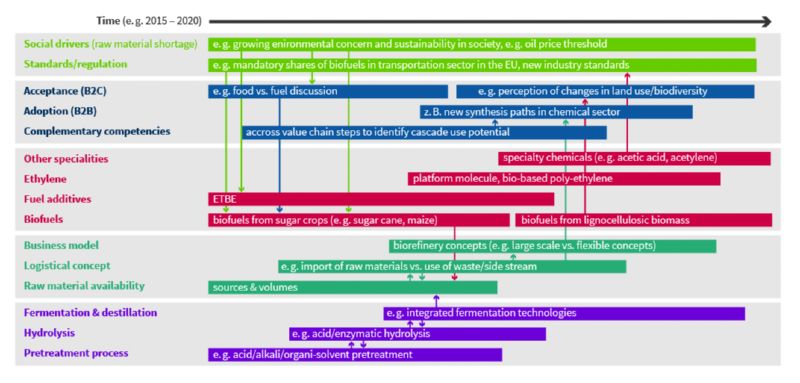
Bioeconomies are increasingly globally interconnected through biomass trade and international knowledge transfer that promotes technological innovations. Quantitative approaches such as modelling and scenario development can help to assess the sustainability impacts of bioeconomic change and allow prospective analysis of potential innovation paths including the convergence of previously separate technology sectors. The Econ-BioSC project enabled the development of an innovative model system and a roadmapping approach for applied sustainable research and policy advice.
Technological innovation in bio-based value chains is essential to supply the growing world population with food and feed as well as biofuel and biomaterials. For example, improved agricultural technologies enable the production of food while using fewer resources such as land or water. Accordingly, the more efficient conversion of biomass in the processing industry and the recovery of valuable components from waste streams can increase the value added in bio-based supply chains. However, such benefits do not always accrue automatically when new technologies are introduced in complex global value chains. Instead, sustainability often requires appropriate socioeconomic and political frameworks, which can vary substantially at global scale and across biomass exporting and importing countries.
Europe leaves an enormous footprint
The Food and Agriculture Biomass Input-Output Model was developed in the framework of the Econ-BioSC project. It quantifies the land footprint of global trade with bio-based products over time. The researchers investigated the dynamics of the non-food biomass footprint of the European Union in terms of land requirements. The land footprint is the amount of land needed to produce the equivalent biomass used by an average EU citizen in one year. The researchers found that the total EU non-food biomass footprint has increased from 477 to 562 square meters between 1995 and 2010. For 2010, two thirds of this footprint occurred abroad, for example, in Asia or Latin America. Palm oil and soya account for the lion’s share of EU non-food biomass imports and are often used as animal feed.

In order to further understand the sustainability effects of the corresponding biomass imports, the team quantified the carbon emissions of selected biomass streams such as soy, which is mainly imported to the European Union from Brazil. The carbon footprint of EU soy imports from Brazil is one of the highest in the world, in part because the EU sources from from regions in Brazil that are characterized by comparatively high levels of both legal and illegal deforestation. The research suggest that the undesirable environmental impact of EU soy imports is mainly caused by illegal deforestation. Tropical forest losses can also be driven by technological innovations in agriculture, which allow the production in fragile ecosystems previously unsuitable for soy cultivation. Good news comes from further studies that show how well-designed environmental policies in Brazil have been temporarily effective in reducing illegal deforestation while simultaneously increasing agricultural productivity. Technological innovation thus often requires accompanying regulatory policy action in order to unfold its potential for sustainable transformation.
Intelligent networking of industrial sectors
Together with the bioeconomy, the connection between the agricultural and energy sectors increases, potentially leading to so called industry convergence. This is due to multiple cross-sector interactions, since both sectors increasingly share the same raw material base. In addition, they share technologies associated with the processing of biomass as well as bio-based materials from side-streams classified as renewable energy. Since technological interfaces between sectors have been described as sources of radical innovation, the cross-sector application of the most important basic technologies has the potential to trigger novel bioeconomic value chains. To elucidate the status quo and the dynamics involved with the development of the bioeconomy, the scientists conducted a patent analysis to map the technology innovation system around second-generation bioethanol production. This revealed that the technological development in lignocellulosic bioethanol is diverse. Lignocelluloses make up about 95 percent of the dry mass of land plants. They are available in large quantities and addresses numerous application fields, including fuel and material uses. However, lignocellulosic ethanol production has not yet reached full commercialization. A subsequent analysis of business news highlighted that pilot production plants are often established in close collaboration between research institutes and industry partners, stressing the need to form novel knowledge ecosystems involving partners from different sectors.

Implications for the future
Sustainable bioeconomic transformation requires supportive consumption, policy and management decisions based on knowledge-based impact assessment. The Econ-BioSC project developed and applied innovative assessment and planning tools that assist in estimating past as well as future sustainability effects of bio-based consumption and improve the understanding of the underlying innovation systems. There are limits to value chain transparency and the reliability of scenario assumptions. Nonetheless, synergies between digitalization and the availability of new data, as well as increasing consumer awareness, can assist in making bioeconomic transformations more sustainable.
Project Coordinator
Prof. Dr. Jan Börner
ILR – Economics of Sustainable Land Use and Bioeconomy, Universität Bonn
Email
Particpating Core Groups
Prof. Dr. Stefanie Bröring, Dr. Nina Preschitschek
ILR – Technology, Innovation Management and Entrepreneurship, Universität Bonn
Prof. Dr. Ulrich Schurr, Dr. Martin Bruckner
IBG-2 Plant Sciences, Forschungszentrum Jülich
Prof. Dr. Jan Börner
ILR – Economics of Sustainable Land Use and Bioeconomy, Universität Bonn
Funding Period
01.03.2015 – 29.02.2016
Funding
Econ-BioSC is part of the NRW-Strategieprojekt BioSC and thus funded by the Ministry of Culture and Science of the German State of North Rhine-Westphalia.